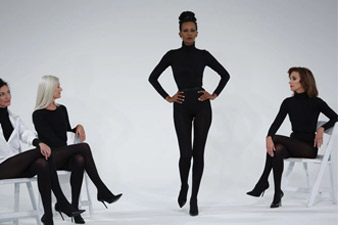
10/09/2014 15:44
Models finally speak: In gestures, monologues — and heels
Old-timers in the fashion industry fondly recall the days when models actively emoted on the runway — when they signified their mood by tilting their head just so, gave their colleagues a piece of their mind with the hauteur in their strut and whispered R-rated paragraphs with the sway of their hips. But for all that models were able to convey on the catwalk with their poise and grace, they did not speak.
They were not regularly interrogated backstage about their fashion show routines. They did not have their own social media campaigns. They were mute. And in large measure, what they did and how they felt doing it, was a mystery.
That was the impetus for “Models never talk,” a stage presentation Monday evening created by Olivier Saillard, who is the director of Paris’s Palais Galliera fashion museum. The unique show, which was part personal monologue and part performance art, starred seven veteran models who worked with some of fashion’s most prominent design houses – Yves Saint Laurent, Thierry Mugler, Jean-Paul Gaultier, Commes des Garçons and others. They shared some of their most memorable experiences in fashion — not stories about parties or boyfriends, but those private moments when a designer says “you’re too curvy” or a seamstress stitches a dress extra tight because the model wants to feel sexier. They also recalled those very public moments when they walked down a runway, entrusted with the job of presenting a designer’s work to the world.
On a bare stage and wearing only black tights and leotards – occasionally a white shirt or dressing robe – and high black heels, they painted detailed pictures of garments through minimal words and discrete gestures. A shrug of the shoulders indicated the strict tailoring of a blazer. The gripping of the waist with the hands suggested the binding tightness of a corset.
Amalia Vairelli – black skin, almond-shaped eyes, cat-like physique – was one of Saint Laurent’s favorite fit models. With a tug at imaginary sleeves and a sweeping gesture that indicated satin stripes, she made the audience see one of Saint Laurent’s famous women’s tuxedos, “le smoking.” And then with a subtle shift of her hips, a well-placed hand on her waist and a discrete rounding of her back, she evoked the smoldering images of the 1970s when Saint Laurent’s gender-bending style was so daring and transgressive.
Claudia Huidobro, a tall brunette with a strong nose and dark, intense eyes, walked the runway for Yohji Yamamoto and Comme des Garcons’ Rei Kawakubo. On stage, she described the look in brusque terms: no makeup, dark eyebrows, asymmetry, flat shoes. Once she began to move, stomping around the performance space, no smile, no affect – she eloquently summarized the shift in fashion brought on by the influx of Japanese designers into Paris in the 1980s: the change in posture, the de-glamorization of the body and the chipping away at the pedestal on which women had been imprisoned.
But it was the magnificent Charlotte Flossaut who told the story that would make the greatest number of women sigh in frustrated recognition. Flossaut modeled for John Galliano during his time as creative director of Christian Dior, when his work was so fanciful, so disconnected from reality and so often, unkind to women.
She wore mile-high heels and a narrow, narrow pencil skirt that fell below the knees. And she leaned forward to indicate precisely where the hem ended. Walking would be an ordeal. As Flossaut stood, she did so gingerly, demonstrating how difficult it was to move in the clothes and the heels while maintaining an expression of calm detachment. She minced her way around the stage. Her legs visibly shaking, her movements slow, her attention desperately focused on remaining upright.
From the audience, model Naomi Campbell – who has balanced atop more than her share of dangerous heels, and occasionally tumbled off them, too — chuckled in empathy.
It’s tempting to believe that so much of what the models on stage conveyed is a slice of history. That is reflects a specific period when models were asked to perform and when they were expected to exude poetry in their gestures. Today, since most designers simply ask a model to walk down the runway, calling as little attention to her individuality as possible, the role of the model has gotten lost in the fashion conversation. When these idealized women do come up in debates, mostly they are parsed for what they represent, not what they do.
Do they speak to the size and shape of the average women? Do they reflect the diverse nature of society? Are they so young that they are, in effect, an insult to modern women? Do their skinny physiques spark eating disorders? What does their rarefied presence mean as we define contemporary beauty?
But in watching these veterans capture the audience’s imagination without benefit of the designers’ extravagant creations, noticing how their posture evokes confidence, sensuality, joie de vivre or menace, the importance of their work in selling a designer’s vision is evident. They are a reminder that a dress is just a few yards of beautiful silk until a woman inhabits it. And if that woman is really just a girl with a gawky gait, no makeup and a sad stare, she may not imbue a garment with grace or confidence, but she still gives it life.








